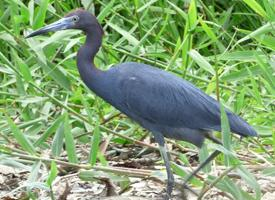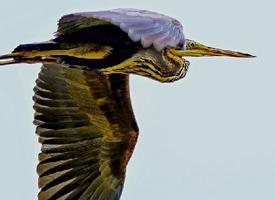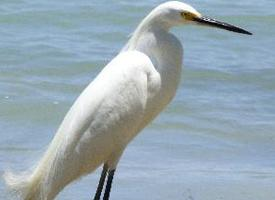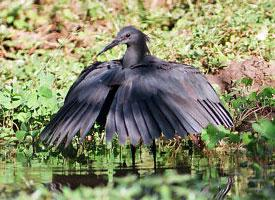
Poids et mesures
| Longueur | 60 cm |
|---|---|
| Poids | 325 g |
| Envergure des ailes | 102 cm |
Description de l'animal
The Little Blue Heron (Egretta caerulea) is a small to medium-sized wading bird, a member of the heron family Ardeidae, which is native to parts of the Americas, including the southeastern United States, Central America, the Caribbean, and South America as far south as Peru and Uruguay. This species is notable for its striking plumage transformation from juvenile to adult, which serves as a distinctive feature among herons.Adult Little Blue Herons possess a unique, monochromatic plumage that sets them apart in their natural habitat. They exhibit a rich, slate-blue coloration across the majority of their bodies, with a slightly purplish head and neck. The bill is a pale, almost ivory color tipped with black, and the legs and feet are a contrasting dark, almost black hue. This dark plumage is especially effective for blending into the shadowy waters of their feeding grounds, making them less visible to prey.
Juvenile Little Blue Herons, on the other hand, display a starkly different appearance from their adult counterparts. They are predominantly white, which often leads to them being mistaken for other species of herons or egrets in their first year of life. As they mature, their plumage gradually transitions through a mottled phase, mixing white with the blue-gray that characterizes their adult plumage. This unique transformation takes about a year to complete, with some individuals showing an interesting patchwork of white and blue feathers during the process.
Little Blue Herons are relatively small compared to other heron species, with a body length typically ranging from 60 to 70 cm (24 to 28 inches) and a wingspan of about 100 cm (39 inches). Despite their smaller size, they are agile and efficient predators. Their diet primarily consists of fish, but they will also consume a wide variety of aquatic prey, including insects, amphibians, crustaceans, and small reptiles.
These birds are most commonly found in shallow waters, such as freshwater marshes, swamps, and the edges of ponds and lakes, where they can be seen stalking their prey with deliberate movements. Little Blue Herons use a variety of foraging techniques, including standing still and waiting for prey to come within striking distance or walking slowly to flush out potential food sources.
Breeding season sees the Little Blue Heron building stick nests in trees or shrubs, often over water. They may nest in small colonies, sometimes alongside other wading birds, which provides added protection against predators. Both parents are involved in the nesting process, from constructing the nest to feeding the young.
Despite facing threats such as habitat destruction and pollution, the Little Blue Heron is currently listed as Least Concern by the International Union for Conservation of Nature (IUCN), indicating a stable population across its range. Conservation efforts continue to ensure that this unique and beautiful bird remains a common sight in its natural habitat.
Animaux similaires
Nouvelles photos d'animaux
Top 10 des animaux
- Dolphin gull (Leucophaeus scoresbii)
- Diana monkey (Cercopithecus diana)
- Moustached guenon (Cercopithecus cephus)
- Galápagos tortoise (Geochelone nigra complex)
- Japanese macaque (Macaca fuscata)
- Stone loach (Barbatula barbatula)
- Russian tortoise (Testudo horsfieldii)
- Greek tortoise (Testudo graeca)
- Common flying dragon (Draco volans)
- Vendace (Coregonus albula)


